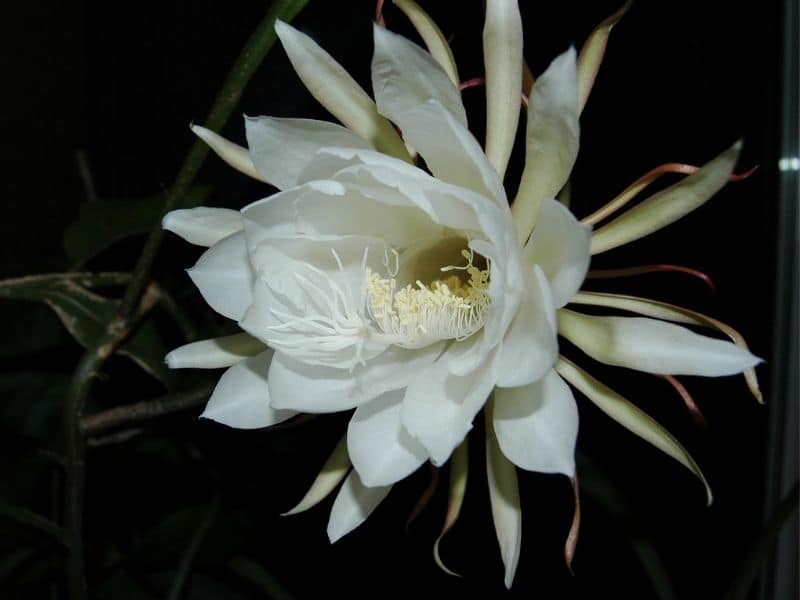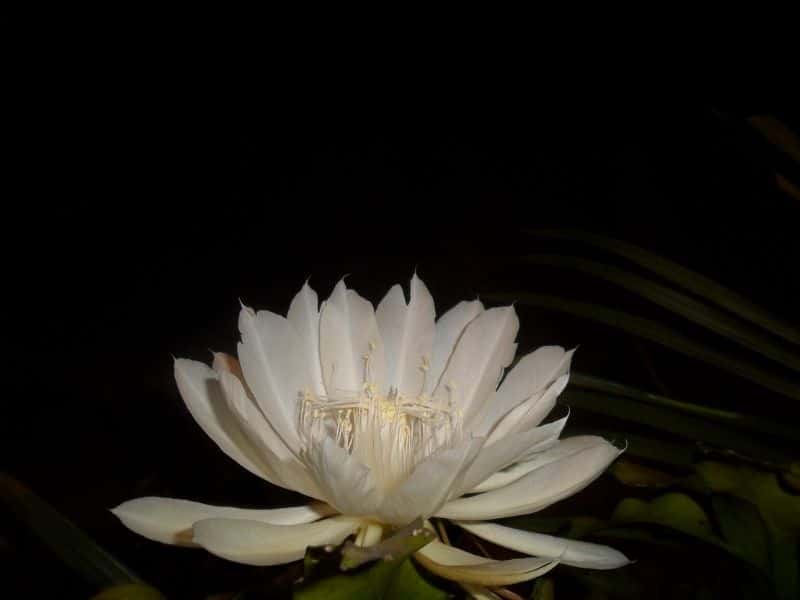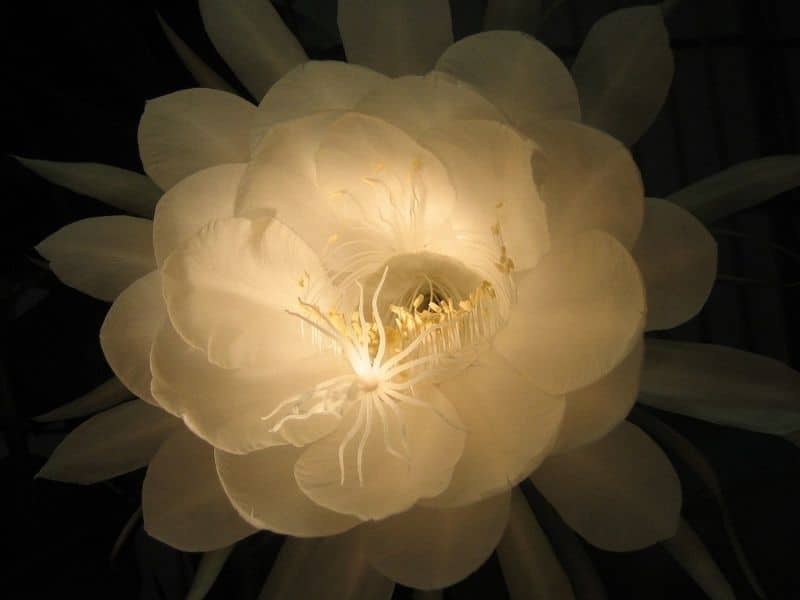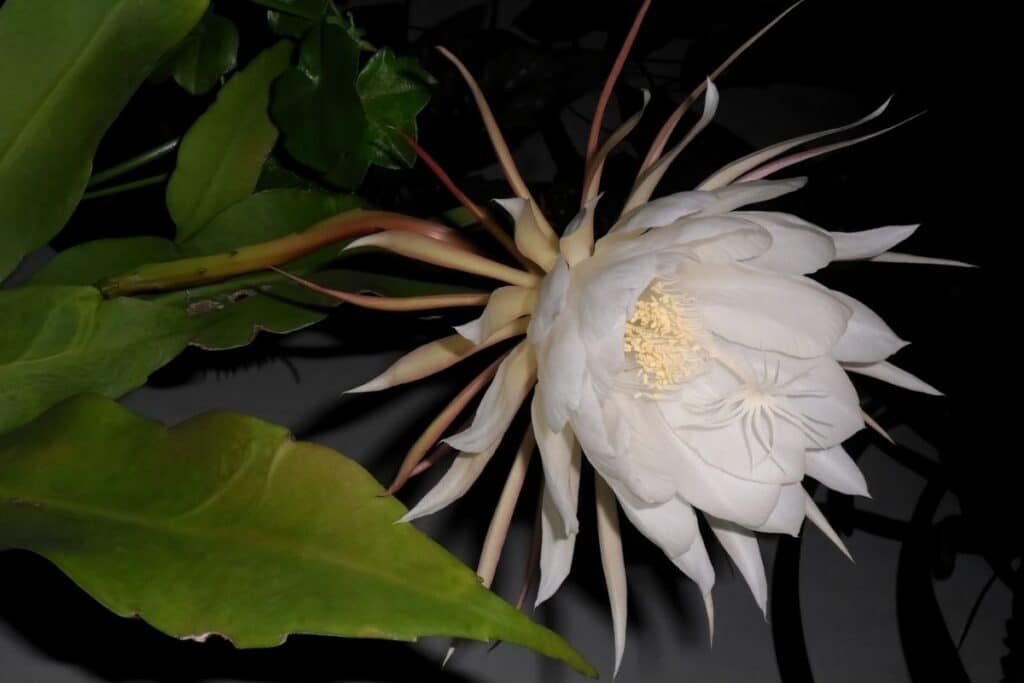Queen of the night is scientifically known as Epiphyllum oxypetalum. Colloquially, it is also referred to as the Dutchman’s pipe cactus.
This plant is so easy to grow that it is the most cultivated species within its genus family of cacti.
As its name suggests, this cactus only blooms during the night, if it decides to bloom at all. In fact, it is perfectly common for it to wilt before the sunrise!
Continue reading if you would like to learn more about the Queen of the Night cactus!
Basic Facts about Queen of The Night Plant
- It’s hardy in zones 10 to 11, according to the USDA.
- This plant can grow up to 10 feet tall, however, she is an epiphytes plant, which means that she needs to be close to other plants, as she needs all the support she can get. In other words, she grows on other flowers or plants.
- The Epiphyllum oxypetalum is known for its sweet fragrance yet strong.
- This tropical cactus is native to Mexico and the southern states of North America, although it can also be found in some areas in South and Central America.
- Its large white flowers can grow up to 7 inches in diameter, and they will only bloom throughout the summer.
- Even though it belongs to the Cactaceae family of plants, the queen of the night’s growing requirements is more in tune with those of a tropical plant.
- Its petals can be white, yellow, pink, and cream.
How To Grow Queen of The Night Flower

The queen of the night can be grown indoors or outdoors. Here is what must be done to have a healthy plant:
Choosing the Correct Site
If grown indoors, make sure the plant is in a bright area. However, keep it away from direct sunlight, otherwise, the plant may suffer.
On the other hand, if you are growing it outdoors, it would be best if you place them in a container. This way, you will have more freedom to move it around if necessary.
Make sure they are underneath a partial shade, as they cannot receive direct morning sun rays for just a few hours. If you have a tree or a canopy, then this is the ideal place to plant outdoors the epiphyllum oxypetalum.
Frost Tolerance

As a cactus family member, the night queen grows best in warm climates and won’t tolerate freezing temperatures. So, if you live in a cold gardening zone, bring the plants inside during winter, but make sure they are far away from any windows or doors.
On the contrary, if they are grown outdoors, then you can build a simple structure and place some fabric on top of it. This way, your plant will survive in winter.
Soil Requirements
The Epiphyllum Oxypetalum is such a unique cactus that it even needs to have moist soil. Most of them are grown in humid climates, so the soil cannot be completely dried, otherwise, the plant will die. This plant prefers slightly acidic succulent potting mix that is well-draining and allows for dry soil between watering.
Watering Needs
This plant needs water to survive! Do not allow the soil to become entirely dried, otherwise, the plant’s roots won’t develop. Also, the flower must have well-drained soil.
This way, the roots won’t rot either. Over watering can cause root rot, which can be fatal to your bamboo palm.
Depending on the location, you should water this plant every week during summer, especially if the weather is dry and hot.
It would be best if watering occurs every 2 to 3 weeks during winter, but again, it will depend on your location.
Another thing to be aware of is that if the plants are young, then they will need more water. On the contrary, if the plants are mature, they won’t need as much water.
Blooms

Most people who own a queen of the night plant have only seen the plant bloom once. Some individuals are not lucky and have not seen it at all! This flower releases a sweet scent that catches everyone’s attention, as it smells nice.
This white flower resembles a spider. It is very delicate looking, and this makes it even more interesting, considering it’s a cactus. Blooming tends to occur during the summer rains, as this plant needs the ideal climate conditions to show itself fully to the outer world. The queen of the night’s flower starts to open around 8-10 PM and can achieve full bloom between midnight and 3 AM.
Propagating
The Queen of the Night flower, a captivating night-blooming cactus (Epiphyllum oxypetalum), can be propagated through two primary methods.
The first involves selecting healthy long stems with multiple leaf segments, making clean stem cuttings, and allowing the stem to dry for a day to form a protective callus. Subsequently, the dried cutting is planted in well-draining soil, buried a couple of inches deep.
Propagating the Queen of the Night flower (Epiphyllum oxypetalum) can be achieved through leaf cuttings. Simply select a healthy leaf segment, let it dry for a day, and then plant it in well-draining soil. Water sparingly and place the cutting in bright, indirect light.
With patience, roots will develop, giving rise to a new Queen of the Night plant. This method offers an efficient and straightforward way to propagate this captivating cactus.
Pests
These night blooming flowers tend to have fungal leaf spots. This tends to happen during spring when the weather is still chilly, and rains are often just around the corner. If only a few spots are found, then try cutting that affected area.
Another common fungal disease that affects the queen of the night plant is powdery mildew, which looks like a white powdery substance on the plant’s stems. This harmless condition is usually the result of overly humid conditions.
What Can These Flowers Be Used For?
The Queen of the Night flower (Epiphyllum oxypetalum) serves primarily as an ornamental plant, captivating enthusiasts with its breathtaking and fragrant night blooms.
Widely cultivated for its aesthetic appeal, this unique cactus is a popular choice for gardens and indoor spaces, especially in areas where its blooming schedule can be anticipated and enjoyed. While it doesn’t have significant practical applications beyond its visual allure, the Queen of the Night contributes to the beauty of botanical collections and offers a sense of wonder with its enchanting, ephemeral blossoms.
Its role is primarily decorative, providing a touch of magic to gardens and spaces where its spectacular nocturnal display can be appreciated.
FAQs
Why does queen of the night only bloom once a year?
The Queen of the Night, a night-blooming cereus (Epiphyllum oxypetalum), typically blooms once a year because its flowers are adapted to open at night and are often pollinated by nocturnal insects. This synchronized blooming strategy increases the chances of successful pollination.
What does queen of the night flower symbolize?
The Queen of the Night flower is often associated with symbolisms of beauty, mystery, and fleeting moments. Its short-lived, fragrant blooms that open exclusively at night contribute to the symbolism of ephemeral beauty and the enchantment of the nighttime.
Is the queen of the night flower rare?
While the Queen of the Night flower is not extremely rare, its blooming patterns and the transient nature of its flowers make it a sought-after and prized plant among enthusiasts. Cultivation and appreciation of this unique flowering cactus add to its allure and desirability in horticulture.
Conclusion
Although to some gardeners queen of the night flower may seem like a difficult plant, the reality is that, if you want to be one of the few lucky individuals to see the flower, then you need to put in the effort and take care of it.
But it will be worth it! The beautiful Epiphyllum oxypetalum plant is known for giving amazing shows to those who wait for her to appear! This plant is a popular choice for moon gardens, which are landscapes designed to make it possible for you to enjoy them at night, even without flooding your backyard with tons of artificial light.
These gardens include plants with white flowers and silver or variegated foliage that can be seen in the reflected light from the moon.
See more: Night Blooming Flowers List
*image by depositphotos.com/Wirestock







